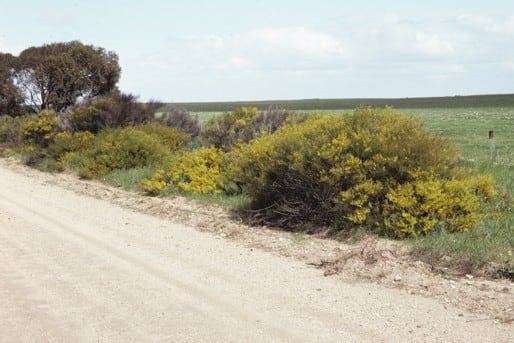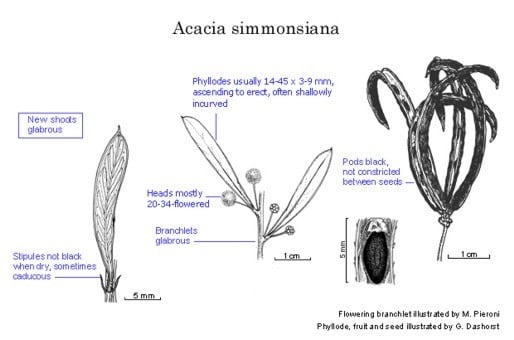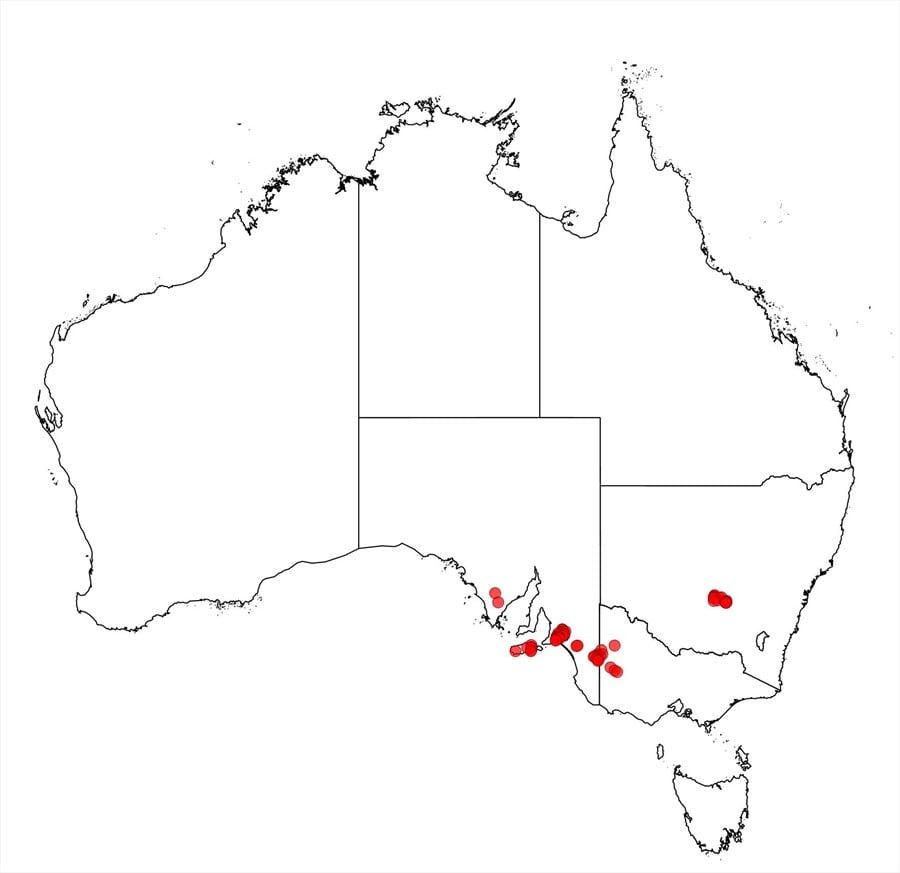Acacia simmonsiana O'Leary & Maslin
WATTLE
Acacias of Australia
Common Name
Simmons’ Wattle
Family
Fabaceae
Distribution
Discontinuous in south-eastern Australia where it occurs from Kangaroo Is., southern Lofty and lower Murray regions in S.A., to Little and Big Deserts in Vic., and near West Wyalong in N.S.W. The Eyre Penin. occurrence of this species noted by B.R.Maslin, Fl. Australia 11A: 577 (2001) is now considered erroneous.
Description
Bushy, spreading shrub to 2 m high. Branchlets angled apically, soon terete and ribbed, glabrous. New shoots glabrous. Stipules 2–4 (–5) mm long, brittle. Phyllodes mostly oblanceolate, straight to shallowly incurved, (1.2–) 1.4–4.5 (–7.2) cm long, (2–) 3–9 (–15) mm wide, narrowed at apex to a small, straight to hooked, innocuous to coarsely pungent point, coriaceous, glabrous, green to grey-green, 1-nerved per face; gland normally single, occasionally absent or 2, (2–) 5–16 (–20) mm above pulvinus. Inflorescences simple and commonly 2 per axil, sometimes rudimentary 1- or 2-headed racemes with axes to 1 mm long; peduncles (2–) 4–10 mm long, glabrous; heads globular, 4–5 mm diam. (dry), (16–) 20–34 (–36)-flowered, golden. Flowers 5-merous; sepals free. Pods ± terete, not or scarcely constricted between the seeds, strongly curved, to 7 cm long, 1.5–4 mm wide, firmly chartaceous to thinly crustaceous, black. Seeds longitudinal, 3–4 mm long; aril terminal, conical, creamy white.
Phenology
Flowers Aug.–Oct.
Habitat
Favours shallow depressions in undulating country on loam over limestone or ironstone, in mallee and Peppermint Box woodland.
Specimens
S.A.: Lower Murray R. on L. Alexandrina, c. 15 km to Milang, N.Gemmell 159 (AD); Hundred Line Rd, Kangaroo Is., M.C.O’Leary 2371 (AD, PERTH). N.S.W.: 4.8 km NE of West Wyalong, R.Coveny 2376 (NSW, PERTH). Vic.: Little Desert, Sept. 1930, H.B.Williamson s.n. (MEL).
Notes
Most closely related to the more northerly distributed A. halliana which differs most obviously in its normally hairy branchlets and new shoots, generally larger and straight to shallowly recurved phyllodes, larger and more densely flowered heads and pods that are clearly constricted between seeds, see M.O’Leary & B.R.Maslin (J. Adelaide Bot. Gard. 20: 9 (2002)) for further discussion. Related also to A. merrallii, which differs in its thicker, often shorter and broader phyllodes and orange or bright yellow arils enclosing to 1/3 of seed, and seemingly also to the W.A. endemic A. mutabilis which differs by the adaxial margin of its phyllodes being 2-nerved in the basal portion of the phyllode, see M.O’Leary & B.R.Maslin (J. Adelaide Bot. Gard. 20: 9 (2002)) for further discussion. Superficially resembles A. × grayana.
The Wuerth paralectotype of A. iteaphylla var. latifolia collected from the Murray R. is A. simmonsiana, see B.R.Maslin, Nuytsia 12: 353 (1999). The concept of A. microcarpa var. linearis (= A. × grayana) by J.H.Willis, Victorian Naturalist 73: 156 (1957), was based in part on a specimen of A. simmonsiana, fide B.R.Maslin, Nuytsia 6: 39 (1987).
This species was noted as Variant 2 under A. halliana by B.R.Maslin in Fl. Australia 11A: 577 (2001).
FOA Reference
Data derived from Flora of Australia Volumes 11A (2001), 11B (2001) and 12 (1998), products of ABRS, ©Commonwealth of Australia
Author
B.R.Maslin, J.Reid
This identification key and fact sheets are available as a mobile application:
URL: https://apps.lucidcentral.org/wattle/
© Copyright 2018. All rights reserved.










